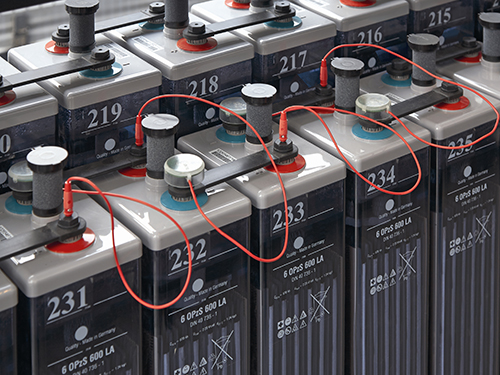

BATTERY TEMPERATURE MONITOR
A simple way to monitor battery temperature manually is by checking it once or twice a week with an IR temperature gun and recording the data. The temperature difference should not exceed 3°C. For automation, a permanent 24/7 monitoring system with a temperature sensor on the battery’s negative terminal is a more efficient solution.
You will have a graph of the temperature, and with the addition of an ambient temperature sensor, the two can be plotted on the same graph and the ∆T shown. More advanced battery monitoring systems can monitor individual cell temperatures, charge current, voltage, and load current and voltage.
Faults in a battery and its attached circuits can affect the temperature of the battery. Common faults that result in elevated battery temperature are ground faults, shorted cells, poor ventilation or inadequate cooling, and lost regulation of charging. Battery temperature monitoring can identify these faults, and alert in advance before a thermal runaway takes place.
If the battery temperature is not monitored and properly regulated, permanent damage can occur. At best, some mechanical distortion or change in the chemical composition will occur, resulting in a costly battery replacement. At worst the battery cell can rupture, explode, leak chemicals or cause a fire.
The increased battery temperature is usually manifested on the negative terminal of the battery. When normal operating conditions such as charging and battery load are applied the temperature should not rise more than around 3°C above the ambient temperature. Two temperature sensors can be deployed, one located on the negative terminal of the battery, and the other monitoring the ambient temperature. The difference between the two sensors can then be used to indicate potential battery health issues or failures in the attached circuits.
In simple terms, a battery is a store of energy. It contains chemicals, and the current is a result of reactions taking place between those chemicals. As with all chemical reactions, as temperature increases so do the speed of the reaction. This increased speed of the chemical reaction can improve battery performance, to a point. If the temperature becomes too high, permanent damage to the chemicals (electrolytes) can result, shortening the battery lifespan and number of charging cycles. The worst case is thermal runaway occurs.
At lower temperatures, the battery chemical reactions slow down. The internal resistance of the battery increases, and it’s capacity to produce high current on-demand decreases. This is one reason why on cold days, a car battery can have problems producing enough current to effectively crank the engine. At extremely low temperatures the electrolytes inside the battery may even freeze, causing the battery to stop functioning completely.
In this document, we will focus primarily on battery temperature monitoring for high temperatures, as this is the indicator of battery faults and poor health.
Thermal runaway occurs when the heat generated by the chemical reaction can not be dissipated fast enough and feeds the reaction even more. This chain reaction causes further increases in the battery temperature and destroys the battery cell. More serious than the damage to the battery, which must then be replaced, is the dangers of fire and explosion. If the battery can not eject the heat fast enough, temperatures can quickly reach boiling point and beyond. Physical components of the battery can melt, explosive gases can be released, battery acid can be ejected. At around 160°C the plastic components of the battery will melt.
Lead Acid Batteries undergo an exothermic reaction during charging. That means heat is generated from the chemical reactions taking place. Under normal circumstances, this heat dissipates. But if the battery is overcharged, the charging current can break down the battery water. When water breaks down it releases hydrogen and oxygen gas. This gas can pass the positive plate. If it does, then it reacts to turn back into the water. When this happens, heat is released. The heat released causes the battery temperature to rise, which accelerates the rate of the reaction. As the reaction rate increases the battery cell accepts more charging current, which results in more gassing and so the process continues. A battery temperature monitoring system can check and alert if this situation is evolving.
To efficiently and safely charge a battery the charge voltage should be accurately controlled. The ideal charge voltage changes based on the temperature. Using a battery temperature sensor as an input to your charging system, allows decisions to be made that adjust the charging voltage. As the battery temperature increases, the charge voltage should decrease.
The below graph illustrates this voltage adjustment based on the battery temperature. Without temperature compensation, at low battery temperatures, the charge voltage would be too low. This leads to undercharging of the battery. In lead-acid batteries, undercharging results in damage from sulfation. At high temperatures, the charge voltage is too high. This results in the degradation of the positive plate inside the battery. Both of these conditions result in shortened battery life and a reduction in performance.
AITO is one of the distributer appointed by the Sensia Solutions for the Malaysia and South East Asia. Our website contains a variety of brand types to facilitate the customization of customers’ preferences based on the selection of pertinent criteria.


